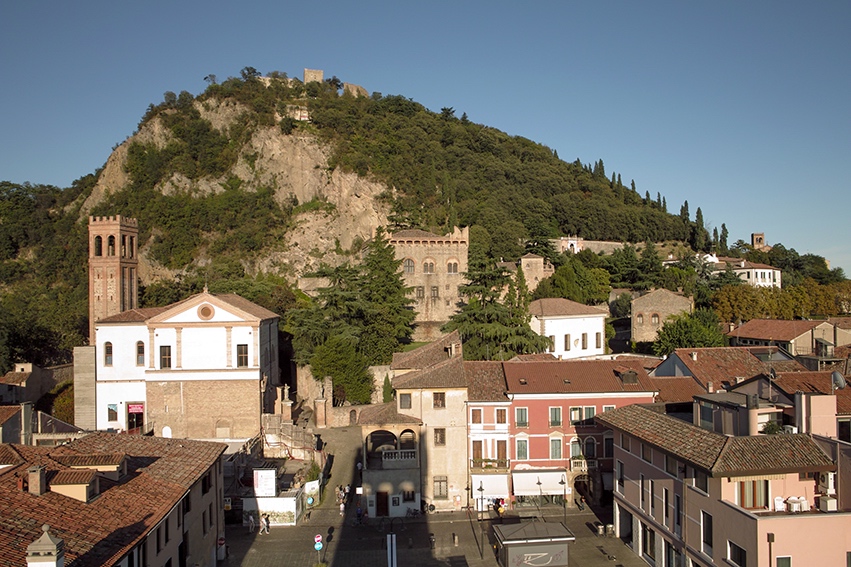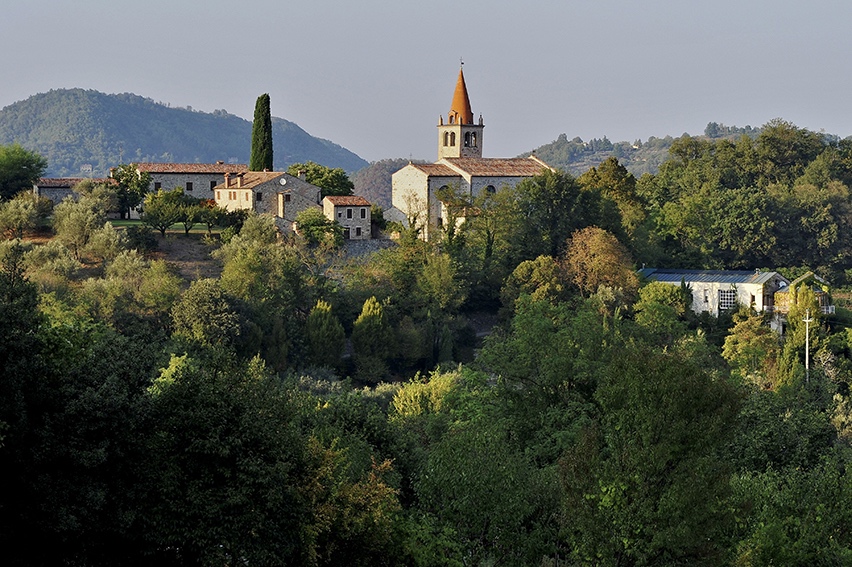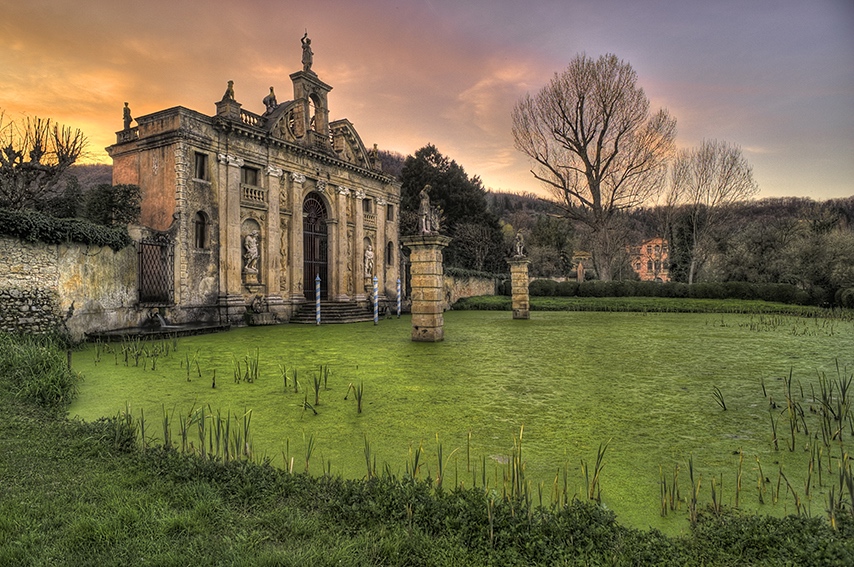Arquà Petrarca
One of the most beautiful villages in Italy, Arquà Petrarca has retained the ancient charm and old-world tranquillity which once won the heart of the poet Petrarch, after who the village is named.He is buried in the churchyard of Santa Maria Assunta.
Not to-be-missed sites include Palazzo Contrarini, a Venetian Gothic mansion, and the other villas which adorn the streets of the centre, including Villa Alessi, the former summer residence of the bishops of Papua; Casa Strozzi, now an art gallery; Villa Rova, a typical example of a 15th century Venetian villa; and just outside the centre Villa Centanin, which houses a permanent exhibition of historic pianos and hosts concerts, including a classical music festival.
Lastly, in the upper part of the village, do not miss Casa del Petrarca, the former home of the great poet, and the Oratorio SS Trinità, the church which was much-loved by Petrarch.
A gem of a place in the heart of the Euganean Hills

Perhaps it was the same peaceful, fairytale atmosphere that can still be felt today that made Petrarch fall in love with this beautifully preserved mediaeval village where life seems to have barely changed since the days of the great poet.
Petrarch first came to this little village in 1370 and was so blown away by its beauty that he decided to take a home in the countryside here which, as the story goes, was given to him by Francesco da Carrara, the Lord of Padua.
Petrarch passed away a few years later in 1374 and was buried in a red marble tomb in the centre of the main square opposite Santa Maria parish church
.His house contains many relics and artefacts from his life and all of the rooms are decorated with frescoes inspired by the poet’s works.
The history of Arquà goes back much further, however. In the lake of the same name, close to the village, evidence has been found of ancient pile-dwellings which show that it was inhabited as far back as prehistoric times, making it perhaps one of the oldest settlements in the whole region. A site of exceptional significance, it now has UNESCO World Heritage status.
Today, this beautiful 14th century village is still a place where you can walk quietly through the cobbled streets, under the airy porticoes, admiring the stunning buildings and their traditional Venetian architecture.A priceless heritage which in recent decades has been restored and enhanced, so much so that Arquà Petrarca has been recognised as one of Italy’s most beautiful villages.
Monselice
A small mediaeval town which has so much to offer, including the castle from the Middle Ages, and a trail linking the seven churches which leads to Villa Duodo, where there are breathtaking views. Explore its history by visiting the Federiciano tower and the San Paolo museum, taking a stroll through the streets and absorbing the timeless atmosphere. It is well worth attending one of its famous mediaeval pageants, such as the Giostra della Rocca, with performers and flag wavers.

Monuments and walks in Monselice
An historic fortified town, Monselice retains the traditional feel of the Middle Ages, in the beautiful surroundings of the Euganean Hills. Entering the town centre, you immediately see the ancient Civic Tower and the castle, a fortress dating back to the early Middle Ages, later renovated and extended.
As you walk along Via del Santuario climbing La Rocca hill, you pass two monuments of particular note, the Palazzo del Monte di Pietà, with its elegant loggia, and the church of San Paolo with the crypt of San Francesco, now the town’s museum.
The most important religious monument in Monselice is the historic Santa Giustina parish church where Petrarch was the canon. Built in the late Romanesque style featuring Gothic elements, it houses a valuable altarpiece by Paolo Veneziano.
Continuing along Via del Santuario you reach the Porta Romana gate, where there is a pretty walk to the Sette Chiese sanctuary, a short pilgrimage which ends at the San Giorgio oratory, part of the Villa Duodo complex. On the top of the hill are the remains of the Federiciano lookout tower, the mighty bastion which overlooks the town, built on the orders of Emperor Frederick II of Swabia.
There are several stately homes in and around the town, such as Villa Pisano, Villa Contrarini and Villa Emo, built by Venetian aristocrats as their summer residences and to govern their lands.
The history of Monselice is brought to life in September with the famous Giostra della Rocca, a contest between the nine districts of the town involving races and games with a mediaeval twist culminating in a spectacular parade with more than 8000 performers in period costume and the Quintana jousting event.From the centre of town, there is a path leading up Monte Ricco, which offers a fantastic view over Monselice: the rock topped by the Federiciano tower, the cathedral, the remains of the town walls and the Sette Chiese trail.
Monselice and St Valentine
There is an interesting link between Monselice and St Valentine, the patron saint of the town, of lovers and of children, whose remains are conserved in the San Giorgio oratory, at the end of the Sette Chiese trail.
On 14 February, Monselice is filled with hearts, with market stalls and shop window displays celebrating the festival of lovers and the traditional key ceremony in the churchyard.
Este
One of the most important walled towns in Veneto, sitting at the foot of the Euganean Hills, Este was the first settlement of the ancient Veneto people who inhabited this area during the Iron Age. An important Roman colony founded by Augustian veterans around the middle of the 11th century, the town became the home of a feudal dynasty.
Of the mighty mediaeval fortress built by the Estensi family and extended by the Carraresi, all that remains is more than one kilometre of the perimeter wall. The two guard towers now enclose a beautiful public garden.
Things to see in Este
Palazzo Mocenigo is home to the National Museum of Este, one of Italy’s most important museums for its pre-Roman collections.
The history of four centuries of Venetian rule is on display in the remains of the perimeter wall which enclose the town, the beautiful palazzi the central square Piazza Maggiore, and the many fine villas. These include Villa Kunkler, where Shelley and Byron once stayed, Villa Cornaro-Benvenuti, Villa Contarini degli Scrigni and Villa Zenobio-Albrizzi.
Among the many religious buildings, we should mention the Cathedral of Santa Tecla, containing the body of Beatrice d’Este, and the magnificent altarpiece by Tiepolo depicting the intervention of Santa Tecla to rid the city of the plague.
Also worth a visit is the Basilica of Santa Maria delle Grazie, built to hold an icon from the Cretan-Byzantine school believed to have miraculous powers, and the church of the Beata Vergine della Salute, a treasure trove of masterpieces by Antonio Zanchi.
Today, the town of Este is still an important centre for high-quality ceramics, which have been produced here almost without interruption since pre-historic times.
Luvigliano di Torreglia
A small village nestling in the hills, with the majestic Villa dei Vescovi standing proudly atop one of them.
Alongside the villa is the Strada del Vino vineyard where you can try local wines and produce, Villa Pollini, once home to the composer, and the small church in this picturesque corner of the Euganean Hills.
Rounding off the appeal of this little village is the footpath which runs from just behind Villa dei Vescovi leading to a beautiful view over Luvigliano.

Valsanzibio di Galzignano
Sitting at the foot of Monte Gallo and Monte Orbieso, the village is well known for the beautiful formal gardens of Villa Barbarigo. It is worth taking a stroll through the picturesque village next to the gardens, with its historic parish church and numerous streets and footpaths which wind their way through the olive groves and vineyards.
Of particular interest are the old church of Sant’Eusebio and the more modern San Lorenzo church. The older church of San Lorenzo has been recently restored both inside and out, bringing to the fore its splendid frescoes.

Valnogaredo di Cinto Euganeo
A tiny village just off the main road between Bastia di Rovolon and Este, on the western side of the Euganean Hills.
Follow the road through the almond and cherry trees until you reach this timeless hamlet where you feel as if you are stepping into a painting.Here you will find Villa Contarini Piva, a church and the Valnogardeo olive press, the only stone-ground olive press in the area that is still operational, using the traditional cold pressing method for the olives.
Has this whetted your appetite for a visit to the mediaeval villages of the Euganean Hills? Now you too can plan your holiday to these places full of history, culture, poetry and old-world charm!